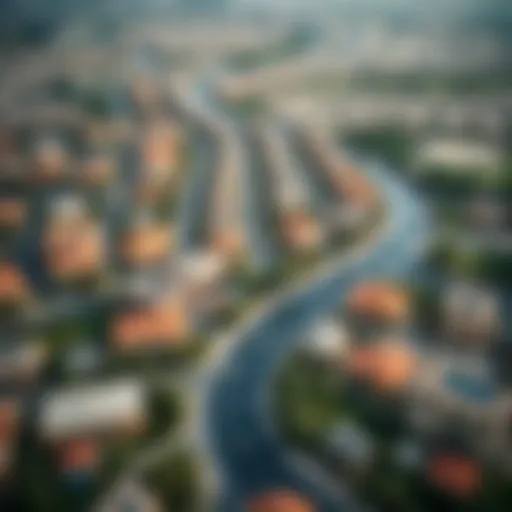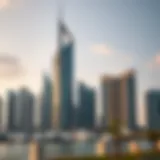An In-Depth Look at Dubai's Comprehensive Map
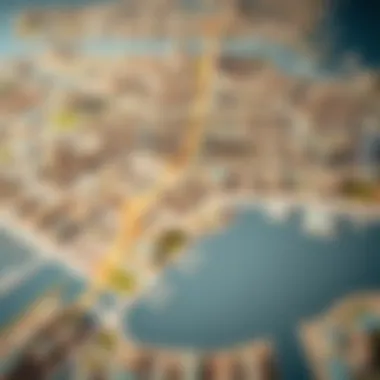
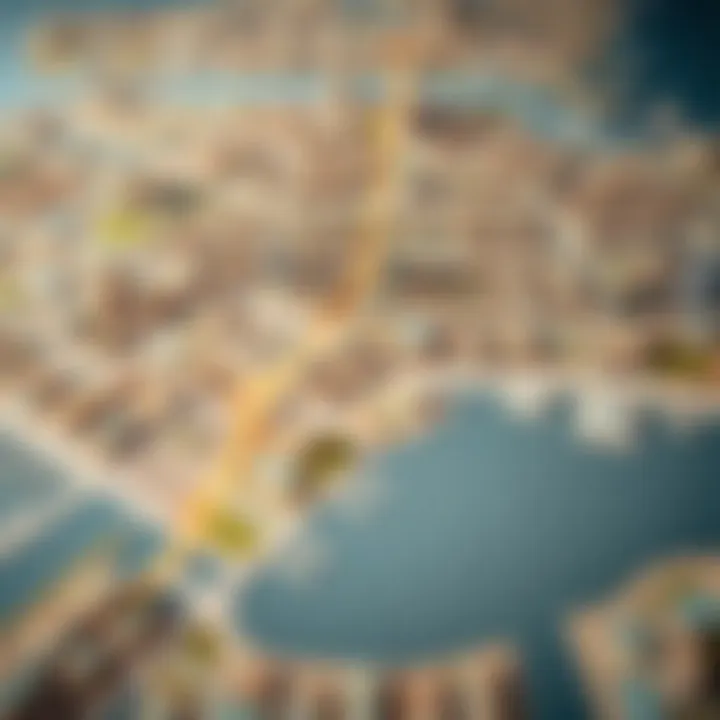
Intro
The city of Dubai, often considered a marvel of modern urban design, boasts an intricate map that reflects both its ambitious architectural undertakings and its cultural heritage. This elaborate grid of neighborhoods, landmarks, and spaces serves not just as a navigation tool but as a narrative of how tradition intertwines with cutting-edge development.
As we delve into Dubai's detailed map, it’s key to appreciate the geographical context. The city sprawls along the shores of the Arabian Gulf, marked by striking contrasts between sandy stretches and towering skyscrapers. Going beyond basic navigation, this guide reveals essential aspects of Dubai's layout which are invaluable for homebuyers, investors, and all sorts of expatriates eager to plant their roots in this vibrant metropolis.
Understanding Dubai’s mapping isn’t merely about knowing roads or areas; it's about grasping the pulse of a city that merges the old with the new. Each section, subsection, and neighborhood encapsulates stories, opportunities, and unique characteristics that define Dubai.
Let's embark on this journey to comprehensively uncover the layers of Dubai's detailed map.
Market Trends
Current Market Analysis
Dubai's real estate market has experienced notable fluctuations in recent years. As of late 2023, there’s a growing trend towards affordability, particularly in up-and-coming neighborhoods. Areas like Dubai South and Jumeirah Village Circle are catching the eye of savvy investors and first-time buyers alike.
From an investor's perspective, understanding the nuances of each district aides in making informed decisions. Knowing where supply and demand converge can spell the difference between scrounging for profit and reaping solid returns.
"Navigating the intricacies of Dubai’s real estate requires more than just mapping; it requires a pulse on market trends and preferences."
This nuanced approach is particularly crucial for expatriates who may not be familiar with the terrain or the socio-economic landscape. By analyzing current trends, potential buyers can align their investments with the city's growth trajectory, making timely decisions that may soon pay dividends.
Future Projections
Looking ahead, the future of Dubai's property market appears dynamic. With ongoing developments, particularly around Expo 2020 venues and the anticipated metro expansion, investment hotspots can shift overnight. Areas projected to see substantial growth include Downtown Dubai and Dubai Marina, fueled by both tourism and an influx of expatriates.
Predictions suggest that the city will continue to evolve, driven by increasing population density and demand for housing. Moreover, the government's focus on diversifying the economy beyond oil will likely bolster investment, especially in technology and renewable energy sectors, thus encouraging innovative real estate developments.
As buyers and investors keep an eye on trends, the city’s continued adaptation and growth remain pertinent. Understanding where the market is heading is crucial to making sound investment choices.
Investment Opportunities
High-Growth Areas
Diving into some of the promising hotspots for investment, it’s hard to overlook places like Al Furjan and Meydan, which are quickly emerging as high-demand neighborhoods. With infrastructure developments and community amenities rapidly expanding, these areas are tailored for those seeking both residential and investment potential. The shifting demographic towards younger families and professionals is creating vibrant communities focused on lifestyle and accessibility.
Key Investment Strategies
As a potential investor, knowing how to navigate these opportunities is essential. Here are a few strategies worth considering:
- Market Research: Keeping abreast of local market conditions and trends helps in identifying hidden gems.
- Long-term Vision: Investing with a long-term perspective can yield better returns, especially in a market that's still maturing.
- Collaborate with Local Experts: Working with real estate professionals who understand Dubai's landscape can give you insider advantages.
For more insights, consider visiting real estate platforms or forums such as reddit.com/r/dubai or real estate agencies specializing in Dubai.
In summary, Dubai’s detailed map is not merely a layout; it's a living document that reflects market dynamics and growth opportunities. A thorough understanding of its intricacies will equip you to navigate this vibrant city, whether it’s discovering your future home or exploring profitable investment avenues.
Understanding the Basics of Dubai's Geography
Understanding the geography of Dubai is like deciphering a complex puzzle—each piece connects to form the vibrant tapestry of this global city. This foundational knowledge is critical for anyone looking to navigate the urban landscape effectively, whether you’re an investor, homebuyer, or an expatriate seeking a place to call home. The geographical layout impacts everything from property values to daily commuting.
The Urban Layout of Dubai
Dubai's urban layout is a reflection of rapid growth and innovative planning. Imagine a city where sprawling high-rises sit alongside traditional markets, where each district has its own unique flavor. The city is segmented into various zones, making it easier for residents and visitors alike to find their way around. Major thoroughfares like Sheikh Zayed Road serve as the city’s arteries, linking prominent neighborhoods and landmarks.
Beyond the individual districts, the urban planning emphasizes a blend of modernity with cultural heritage. This approach not only reflects the identity of the city but also enhances its real estate appeal, catering to a diverse population—including business professionals, families, and tourists. Each area offers distinct characteristics that meet various needs and lifestyles, revealing why understanding the urban layout is essential.
Key Geographic Features
Deserts
The deserts of Dubai are not merely vast stretches of sand; they symbolize both a challenge and an opportunity in urban planning. These arid regions contribute to the city’s aesthetic charm, drawing visitors for activities like dune bashing and camel riding. However, they also demand a unique approach to development—air conditioning systems and water conservation must be meticulously integrated into buildings and infrastructure.
"Deserts embody Dubai’s spirit of resilience—turning formidable landscapes into thriving urban spaces."
One key characteristic of Dubai’s desert areas is their ability to host eco-resorts that offer visitors a taste of luxury amidst the stark beauty of sandy dunes. This adds an intriguing layer to the real estate market, presenting options for investors interested in tourism development, yet also poses limitations in terms of accessibility and sustainability.
Coastlines
Dubai's coastlines serve as a stunning contrast to its desert backdrop. They carry not only the allure of beautiful beaches but also the economic weight of trade and tourism. The waterfronts are characterized by unique developments such as the Palm Jumeirah, known for its luxurious villas and high-end hotels. Such features enhance the attractiveness of properties along the coast, making them a popular choice among buyers.
The city’s coastlines also offer recreational activities, bolstering community living. However, maintaining these beautiful shorelines requires ongoing environmental efforts. Coastal erosion and pollution are constant threats, which authorities must address to ensure that both natural beauty and real estate value are preserved.
Natural Reserves
Natural reserves in Dubai highlight a commitment to preserving biodiversity amidst urban expansion. Areas like the Ras Al Khor Wildlife Sanctuary represent a sanctuary for migratory birds and native species, providing a green lung for the city. The preservation of these sites not only boosts eco-tourism but also enriches the community's quality of life by providing green spaces for recreation and relaxation.
This focus on conservation has led to unique land use policies that enhance property values in adjacent areas. Investors should consider the proximity to such reserves, as these locations often come with added desirability factors, improving both aesthetics and investment potential.
Overall, the geographic features of Dubai—its deserts, coastlines, and natural reserves—play an integral role in shaping the city’s identity, influencing everything from urban planning to real estate opportunities. A deep understanding of these facets can provide a significant advantage for those looking to make informed decisions in this dynamic environment.
Further Resources
Major Districts Highlighted in the Map
Understanding the major districts of Dubai is paramount for anyone looking to navigate or invest in this dynamic city. Each district offers its unique character and attractions, representing a blend of tradition and modernity. The districts are not just geographical divisions—they embody the life and pulse of the city.
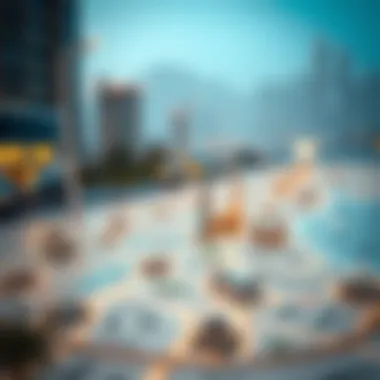
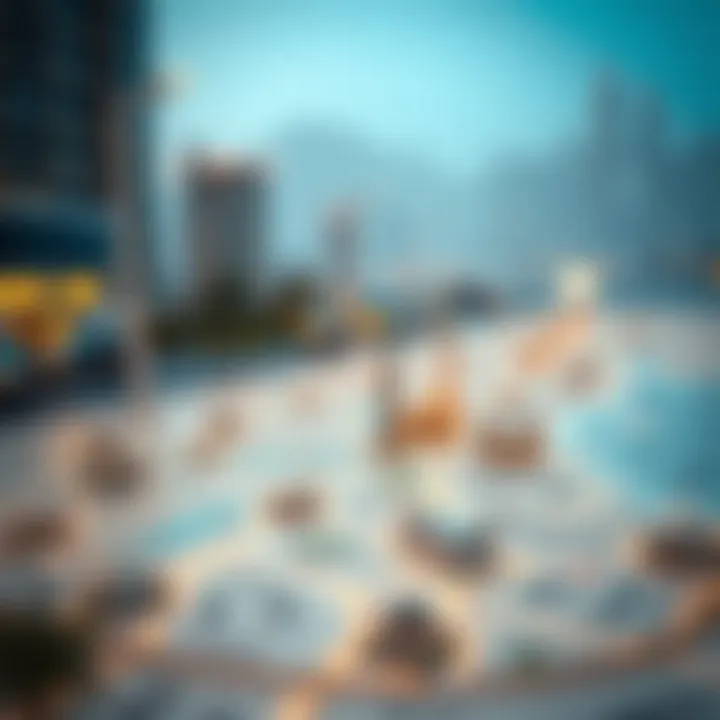
Downtown Dubai
Downtown Dubai serves as the heartbeat of the city. This area is not merely a location; it’s a statement of ambition and development. It houses some of Dubai’s most iconic landmarks, which are essential for any map of the city.
Burj Khalifa
The Burj Khalifa, standing tall at 828 meters, is more than just a skyscraper—it’s a symbol of human ingenuity. As the tallest building in the world, it draws millions of visitors each year, offering breathtaking views of the cityscape. The observation deck at the 148th floor provides a unique vantage point, allowing visitors to soak in the architectural marvels below.
What sets Burj Khalifa apart is not just its height but the way it has reshaped the skyline. The surrounding area, filled with parks and fountains, enhances its appeal, making it a must-visit destination. However, its popularity can sometimes lead to overcrowding, which could dilute the experience for some visitors.
"The Burj Khalifa is not just an architectural feat; it represents the ambitious spirit of Dubai."
The Dubai Mall
The Dubai Mall is one of the largest shopping centers in the world, going beyond mere retail space. It integrates lifestyle, entertainment, and culture, making it a one-stop destination for both locals and tourists. The mall boasts attractions like the Dubai Aquarium and an ice rink, which cater to a variety of interests. The architectural grandeur of the building is complemented by its vast selection of shops and dining options, creating an immersive experience.
What makes The Dubai Mall particularly appealing is its accessibility and the vibrant atmosphere it generates. However, navigating its vast expanse can be challenging for first-time visitors, so having a good map on hand or using the mall’s navigation tools is advisable.
Dubai Marina
Dubai Marina stands out as a prime example of luxury living, designed for those who appreciate a waterfront lifestyle. It showcases an array of skyscrapers and luxurious residential options, along with a bustling promenade that provides a perfect blend of work and play.
High-rise Development
High-rise development in Dubai Marina reflects the city’s modern architectural trends and catering to a diverse populace. These towering structures offer stunning views of the marina and the Arabian Gulf. The combination of aesthetic appeal and functionality makes these buildings attractive choices for investors and residents alike.
However, the rapid pace of development can lead to traffic congestion during peak hours, which is something that potential residents should consider.
Waterfront Lifestyle
The lifestyle in Dubai Marina is unmatched. With its picturesque waterfront, residents enjoy outdoor activities, fine dining, and vibrant nightlife. The area is known for its yacht clubs and community vibe, making it particularly appealing for expatriates and professionals. This unique lifestyle draws many around the globe, enhancing Dubai's reputation as a global city.
Although the waterfront brings numerous benefits, the popularity can sometimes lead to crowded areas, particularly on weekends.
Old Dubai
Old Dubai offers a window into the rich cultural heritage of the emirate, contrasting sharply with its modern counterparts. This area is charming, with winding streets, historical buildings, and a palpable sense of history.
Historical Significance
The historical significance of Old Dubai cannot be overstated. It showcases the origins of Dubai as a trading hub, with landmarks like Al Fahidi Fort and the Dubai Museum narrating tales of the past. Visitors here can truly grasp how far Dubai has come.
This district is essential for understanding the essence of Dubai, as it highlights the juxtaposition of old and new. However, it may not offer the same luxury amenities as the more modern districts—something to weigh if comfort is a priority.
Souks and Cultural Heritage
The souks of Old Dubai provide an authentic shopping experience, filled with local artisans and traders. These markets, such as the Spice Souk and Gold Souk, offer a variety of traditional goods that reflect the local culture. Exploring the souks is a cultural journey, bringing visitors face-to-face with the region's heritage.
The immersive experience of wandering through these bustling markets can be mesmerizing, yet it may not suit those seeking familiar shopping franchises or contemporary conveniences.
Navigational Aspects of the Map
Navigational aspects serve as a critical backbone to understanding Dubai’s detailed map. For anyone looking to traverse the city—be it expatriates seeking neighborhoods, investors scouting for prime real estate, or simply tourists navigating to attractions—this section provides essential insights. The intricacies of road networks and public transportation not only shape commuting patterns but also highlight the accessibility and connectivity of various districts.
By delving into these navigational elements, one can better appreciate how Dubai’s physical layout impacts daily life and investment potential.
Understanding Road Networks
Major Highways
Dubai's major highways, such as Sheikh Zayed Road, stand out as the arteries of urban mobility. This highway is a significant transportation route spanning the length of the city, connecting vital hubs, including Dubai Marina and Downtown Dubai. Its strategic importance lies in its ability to facilitate quick movement through the congested areas of the city. Many choose this pathway due to the fast travel times it offers, an essential benefit in this bustling metropolis.
The unique characteristic of these highways is not just their capacity to handle a high volume of vehicles efficiently but also the panoramic views they offer of some of Dubai's iconic skyscrapers. This can make drives feel less like a chore and more an adventure. However, the downside includes increased traffic, especially during peak hours, which can turn a quick trip into a lengthy wait. Commuters often need to factor in this potential delay when planning their travels across the city.
Interconnecting Roads
Moving beyond the major highways, interconnecting roads provide secondary routes that weave through the various neighborhoods of Dubai. These roads facilitate access to residential areas, office complexes, and commercial establishments that might not be on the primary highway path. Their defining feature is the flexibility they offer—allowing travelers to bypass heavy traffic zones or explore less crowded routes.
These roads support a myriad of smaller destinations, giving rise to a more localized experience of the city. However, they can sometimes pose challenges in terms of navigation, as they may be less straightforward and not as well-indicated as the major highways. A good understanding of these interconnections provides a more comprehensive grasp of how to get around efficiently.
Public Transportation Routes
Public transportation represents a vital component of navigating Dubai, designed to ease the burden of daily traffic.
Metro Lines
The Dubai Metro, an automated and driverless system, is a crown jewel of the city's public transit. It serves numerous districts and connects major attractions with remarkable speed and efficiency. Its key characteristic is the integration of modern technology, which enhances user experience through features such as real-time tracking and air-conditioned stations. This makes it a popular option for both daily commuters and tourists alike.
A unique aspect of the Metro is its stunning stations, which reflect a blend of modern architecture and cultural motifs. Conversely, during peak hours, the Metro can become crowded, making the atmosphere less than ideal for a relaxed travel experience. Still, it remains an invaluable resource for anyone seeking to navigate the city's sprawling landscape efficiently.
Bus Services
Complementing the Metro is Dubai's extensive bus system—often overlooked yet incredibly important. Buses are strategically deployed throughout the city, ensuring that areas not directly connected to the Metro are accessible. The fundamental strength of the bus system lies in its affordability and extensive reach, making it a sensible choice for residents and visitors on a budget.
Notably, buses often adhere to a punctual schedule and are well-maintained, which is a bonus for those relying on public transportation. Nonetheless, the journey can at times be less direct compared to the Metro, with multiple stops that can extend travel times.
Significant Landmarks and Attractions
Dubai is not just a city of towering skyscrapers and lavish lifestyle; it is also a treasure trove of significant landmarks and attractions that reflect its rich culture and innovative spirit. These sites serve as touchstones for residents and tourists alike, offering insights into Dubai's historical context while also showcasing its modern-day marvels. For anyone navigating the intricate map of Dubai, knowing these attractions can enrich the overall experience, making each visit memorable and enlightening.


Cultural Institutions
Museum of the Future
The Museum of the Future is a prime example of Dubai's vision for innovation and technology. Situated at the heart of the city, its architecture alone is striking, resembling a silver crescent adorned with Arabic calligraphy. This museum is not merely about exhibits; it serves as a hub for ideas and creativity, focusing on themes such as sustainability and human enhancement.
A visit here offers guests a chance to dive into immersive experiences that challenge the mind and stimulate curiosity. The museum attracts tourists and locals, providing a unique space for dialogues on the future of humanity and our planet. Its focus on future technologies makes it a worthwhile location for those considering investments in emerging industries.
Unique Feature: The experiences within change frequently, offering a continual sense of novelty, which keeps visitors returning. However, some may find the ticket prices steep compared to other attractions, yet the insight gained can often outweigh these costs.
Dubai Opera
The Dubai Opera is the city’s cultural gem and stands right by the waterfront in Downtown Dubai. Its architectural design mimics the silhouette of a traditional dhow, a nod to Dubai’s maritime heritage. This venue has hosted a variety of performances—from operas to concerts—making it a multifunctional space that enriches Dubai’s cultural landscape.
The venue not only enhances tourism but also supports local arts, encouraging a thriving community of artists and performers. Attending a show at the Dubai Opera offers a glimpse of the city’s artistic flair and serves as a platform for cultural exchange.
Unique Feature: The venue doubles as a restaurant and lounge, allowing visitors to enjoy fine dining alongside premium entertainment. While some may argue it leans towards the upscale side, the experience can be priceless for those with an appreciation for the performing arts.
Parks and Recreational Areas
Public Beaches
Public beaches in Dubai are a significant draw for both residents and tourists. Places like Jumeirah Beach and Kite Beach have become social hubs where people gather to soak in the sun and enjoy various watersports. These beaches provide not only relaxation but also vibrant social scenes, especially during weekends and holidays.
The coastline is lined with cafes and outdoor facilities that cater to a wide array of tastes and preferences. With clean sands and clear waters, these public beaches lay the foundation for a lifestyle that balances urban living with relaxation. They also offer a glimpse into Dubai's commitment to promoting a healthy and active lifestyle among its residents.
Unique Feature: The accessibility of these beaches makes them a favorite among locals and visitors, although the high influx of visitors can sometimes make them crowded, overshadowing the tranquility one might seek.
Green Spaces
Dubai has made strides in incorporating green spaces into its urban environment, with parks like Al Barsha Park and Safa Park providing vital pockets of nature amidst the concrete. These parks are essential for community engagement, offering venues for outdoor activities including jogging, picnicking, or simply enjoying a stroll.
The green spaces act as a refuge from the bustling city life, promoting wellness and social interaction. Their availability reflects Dubai’s initiative toward sustainability, aiming to enhance the quality of life for its citizens.
Unique Feature: Many parks also host events, making them lively centers for community culture. However, the limited number of health-focused facilities compared to commercial developments may leave some visitors wanting more in terms of amenities.
Understanding the Zones of Dubai
Understanding the various zones of Dubai is pivotal for anyone looking to make sense of this diverse metropolis. The city's zones are not just geographical divisions but also reflect the lifestyle and cultural dynamics of its residents. Knowing about these areas gives investors, expatriates, and homebuyers a clearer picture of where to put down roots or start a business.
Each zone harbors its own unique vibe and offers distinct benefits. From the high-end luxury living spaces to affordable housing options, and bustling commercial districts to subtle, local experiences, these zones cater to a myriad of preferences and needs. This exploration will ensure that readers grasp the real estate landscape comprehensively, aiding in their decision-making processes.
Residential Zones
Residential zones in Dubai are essential to the city's framework, serving as the foundation for its growing population. These areas divide into Luxury Areas and Affordable Housing Options, each catering to different demographic segments and lifestyle preferences.
Luxury Areas
Luxury Areas, like Emirates Hills and Palm Jumeirah, are synonymous with extravagance. Properties here often boast stunning architecture, breathtaking views, and high-end amenities. This sector thrives because of the desire for a lifestyle filled with comfort and prestige.
One key characteristic is their prime location, usually situated near vital landmarks or scenic waterfronts, making them very appealing to affluent buyers. Furthermore, properties in these areas not only offer visual appeal but also tend to have strong investment potential, as demand keeps rising.
However, it's worth noting that such luxury comes with steep price tags, making these residences less accessible for the average homebuyer. Market fluctuations can affect property values, and potential buyers need to be cautious and well-informed.
Affordable Housing Options
In contrast, Affordable Housing Options represent a different facet of Dubai's residential offering, where communities like International City and Dubai Sports City come into play. These areas cater primarily to middle-income families and young professionals looking for good-quality housing without breaking the bank.
What makes these areas stand out is their balance of comfort and cost-effectiveness. Many offer extensive amenities and community services that enhance living standards, making them a practical choice for long-term residents.
The unique aspect of affordable housing is the variety of options available, from cozy apartments to reasonable townhouses. Although they are more budget-friendly, some might not match the luxurious charm of higher-end properties. However, their growing environments and accessibility will attract buyers looking for a blend of quality and value.
Commercial Zones
Commercial zones are the lifeblood of Dubai’s economy, showcasing the city’s vibrant business landscape. Within these zones, Business Hubs and Retail Districts form the core of commercial activity.
Business Hubs
Business Hubs such as Dubai Internet City and Dubai Media City are integral to the region's status as a global business center. These zones are designed to attract professionals and multinational companies. One prominent characteristic is the availability of state-of-the-art infrastructure, catering to tech firms and creative industries alike.
The presence of networking opportunities and a collaborative environment makes these Business Hubs immensely appealing. They create a dynamic atmosphere where ideas flourish, beneficial for startups and established enterprises alike. However, as with any commercial space, competition can be fierce, so companies need to be strategic in positioning themselves.
Retail Districts
On the other hand, Retail Districts like The Dubai Mall and Souk Madinat Jumeirah cater to both locals and tourists, making them hotspots for shopping and cultural experiences. A key feature of these areas is their ability to blend retail with entertainment and hospitality, creating a one-stop-shop for leisure and commerce.
These districts thrive on high foot traffic and visibility, essential traits for businesses seeking customer engagement. While retail can be profitable, the saturation in some areas might pose challenges for new enterprises trying to carve out their niche in a competitive market.
Future Developments and Urban Planning
The landscape of Dubai is ever-evolving, reflecting not just its vibrancy but also the ambition it holds for its future. Urban planning is not simply about laying out roads and buildings; it's about crafting a livable and sustainable environment for its residents. This part of the guide dives into the aspirations that shape the city’s future, focusing on key initiatives and projects that promise to transform the urban experience in Dubai.
Smart City Initiatives
Infrastructure Advancements
Infrastructure advancements are fundamental to Dubai's urban strategy. With a growing population and a continual influx of visitors, developing robust infrastructure becomes critical. This includes state-of-the-art transportation systems, smart traffic management, and utilities that enhance daily living. Smart technologies are at the heart of this advancement. For instance, the integration of intelligent traffic signals aims to reduce congestion, ensuring that the flow of people and vehicles remains smooth.
A notable characteristic of these advancements is the emphasis on interconnectivity. This not only facilitates ease of movement but also promotes sustainable travel choices such as cycling and public transportation. The downside, however, can be the high initial costs of implementation, creating a financial pressure even as it pays off in efficiency in the long run.
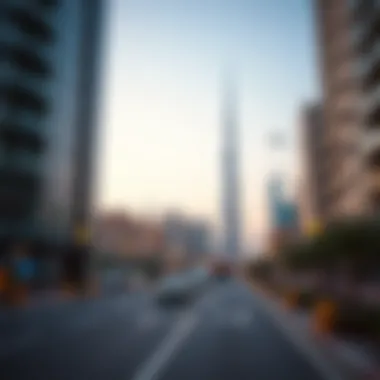

Eco-Friendly Projects
Eco-friendly projects represent a growing trend within Dubai's urban planning efforts. Incorporating sustainability into city development is not just a fad; it’s an essential aspect in addressing climate change and resource scarcity. Projects like the Dubai Sustainable City exemplify these efforts, featuring energy-efficient buildings, green space, and sustainable transport options.
The key feature of such projects is their focus on reducing the carbon footprint. This is becoming increasingly popular because it resonates with both residents and businesses seeking to align with global sustainability norms. The challenge, however, lies in balancing greenery with urban density, as citizens often demand both modern conveniences and natural environments.
Upcoming Real Estate Projects
Vision
Vision 2040 is more than just a plan; it’s a long-term commitment to enhancing living standards in Dubai. This vision encompasses a variety of initiatives, including creating more public spaces, improving transport networks, and upgrading infrastructure across the city. A standout aspect of Vision 2040 is its holistic approach—it's not merely about urban expansion, but rather about smart growth.
This is beneficial for investors as it indicates a long-term potential for property valuation increases. However, it also requires constant assessment to ensure that development meets community needs without compromising quality of life.
Neighborhood Redevelopment
Neighborhood redevelopment is another pivotal part of Dubai’s trajectory. Many areas within the city are being revitalized to enhance livability and promote community engagement. Projects aimed at transforming older neighborhoods into vibrant areas include adding parks, recreational spaces, and mixed-use developments that integrate residential and commercial facilities.
This redevelopment is appealing as it breathes new life into established communities, ensuring they remain relevant and suitable for modern living. However, it risks displacing long-term residents and changing the socio-economic fabric of these neighborhoods, presenting a delicate balancing act for planners and developers.
"Dubai's urban landscape is not just about glass towers and luxury; it's about creating a desirable environment for all its residents."
In summary, as Dubai marches towards an ambitious future marked by smart innovations and inclusive urban planning, investors, homebuyers, and expatriates alike will benefit from staying informed about these developments. They not only influence individual neighborhood dynamics but shape the overall ethos of a city that refuses to remain static.
Utilizing the Map for Real Estate Insights
Understanding the map of Dubai is no small feat, but it plays a pivotal role in making informed real estate decisions. A thorough grasp of the layout, zones, and various landmarks helps investors and homebuyers navigate the complex real estate scene. By utilizing the map effectively, stakeholders can identify prime locations, assess property values, and discover hidden gems that are often overlooked.
The benefits of employing the map extend beyond simple navigation; it allows for a deeper analysis of market data and real-time insights. Recognizing trends and spotting opportunities can make all the difference in the fast-paced environment of real estate in Dubai.
Analyzing Market Trends
Market trends reflect the pulse of the real estate industry, and analyzing these trends through the lens of the map provides a comprehensive overview of property dynamics.
Property Value Fluctuations
Property value fluctuations are vital indicators of a thriving market. They define the landscape of investments and guide buyers in making sound decisions. In a city like Dubai, where the property market can show rapid shifts, understanding these fluctuations is crucial. For instance, areas close to newly developed infrastructures often see values rise steeply as demand increases.
A key characteristic of property value fluctuations is their correlation with economic conditions, foreign investments, and evolving neighborhoods. Investors should keep an eye on these aspects, as they can bode well for property appreciation. One unique feature here is the variance across different districts; perhaps a downtown apartment surges in value while an older neighborhood experiences a downturn. Educated decisions hinge on knowing these trends to minimize risk.
Demand Patterns
Demand patterns are another cornerstone of market evaluation. A consistent rise in demand can signal promising investment opportunities, whereas a sudden drop might indicate a market correction.
These patterns often reflect consumer preferences, shifting demographics, and connectivity improvements. For instance, underwater housing developments might attract young families while services and schools become established. Understanding this demand allows investors to time their purchases and maximize returns.
However, a disadvantage is the potential for over-saturation—too much development can lead to a market where supply outstrips interest, impacting property values negatively.
Locational Advantages
Location truly is at the heart of real estate. A thorough understanding of accessibility and neighborhood amenities can elevate an investment from good to exceptional.
Accessibility
Accessibility is a major factor in any location’s desirability, impacting both property values and rental yields. Areas with easy access to transportation nodes—like the Dubai Metro or major highways—tend to attract more buyers. Investors see the appeal in locations that reduce commuting times and enhance convenience, as it fosters greater demand.
On the flip side, being too far removed from transport hubs might put a property at a disadvantage. Investors must weigh accessibility against other factors like cost and potential future developments in transport infrastructure.
Neighborhood Amenities
Neighborhood amenities play a critical role in defining the living experience in any community. Areas rich with parks, shopping centers, restaurants, and schools are often sought after. These amenities add value, allowing residents to enjoy a more convenient lifestyle, which translates into higher property demand.
A unique feature of neighborhood amenities is their potential for fostering community spirit. Properties in vibrant neighborhoods with good schools and parks not only draw families but also create tight-knit communities, enhancing retention rates. However, there's a caveat; amenities can vary widely between neighborhoods, which calls for meticulous research to identify truly advantageous areas.
"Understanding the dynamic interplay of market trends and locational advantages empowers investors and buyers to make wise decisions."
Overall, utilizing the map of Dubai is indispensable for investors, brokers, and homebuyers alike. Each section of the map tells a story—not just of the landscape, but of the potential it holds for those willing to delve deeper.
Resources for Further Navigation
Navigating Dubai's intricate urban landscape can seem daunting at first. Yet, having a comprehensive set of resources can make the task more manageable and even enjoyable. In this section, we delve into the various tools available for both newcomers and long-time residents to access detailed maps of the city, enhancing their understanding of Dubai's layout and offerings.
Digital Mapping Tools
Mobile Applications
Mobile applications dedicated to mapping have become a game changer in the way people interact with Dubai. These apps, such as Google Maps and Waze, provide real-time updates on traffic conditions, estimated travel times, and estimated distances. One standout characteristic of mobile applications is their ability to use GPS technology. This integration means you can find your way around based on your current location, making it an invaluable resource when exploring a new area or seeking out a specific landmark in the bustling metropolis.
The unique feature of these mobile apps is their user-friendliness and accessibility. Most people keep their smartphones close, which makes access to mapping services almost second nature. However, they do have their drawbacks. For instance, heavy reliance on phone battery life can be a hazard during long explorations, and not every street or new development might be updated promptly. Therefore, while these apps offer convenience and ease, having a backup plan is wise.
Interactive Websites
Interactive websites also play a critical role in navigating Dubai’s landscape. Platforms such as MapQuest and OpenStreetMap allow users to engage with detailed, interactive mappings. They often feature zoom capabilities, customizable layers (like public transport or real estate listings), and satellite imagery. The main advantage of using interactive websites is that they provide an extremely detailed view of specific areas, helping users not only find their way but also understand the context of their surroundings.
One notable characteristic of these websites is that they tend to offer additional resources, such as guides on local amenities or housing statistics. However, they might not always be as mobile-friendly as their app counterparts. The experience can vary greatly depending on internet connection and device capabilities, which could limit usability for some users without stable access.
Printed and Online Maps
While digital solutions are immensely helpful, there is still something to be said about printed and online maps. For many individuals, especially those who prefer a tactile approach, printed maps remain a practical resource. They can be laid out on a table during planning sessions, allowing for a broad overview of areas without the distraction of notifications buzzing from a smartphone.
On the other hand, online maps continue to serve as reliable sources for current information and detailed routes. They typically come enriched with user-generated content and reviews, offering insights that can only be collected from the experiences of others. In short, both printed and online resources serve their purpose effectively, and leveraging both can provide a more rounded perspective of Dubai's vast cityscape.
In today’s tech-savvy world, selecting the right tools for navigation in Dubai can enhance daily experiences, ensuring one can easily access the rich culture and vibrant life that the city has to offer.
Whether considering buying a property or just exploring, familiarizing oneself with both classic and modern navigation resources can make a significant difference in understanding and engaging with Dubai's unique urban fabric.

